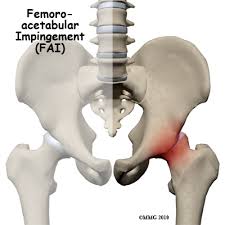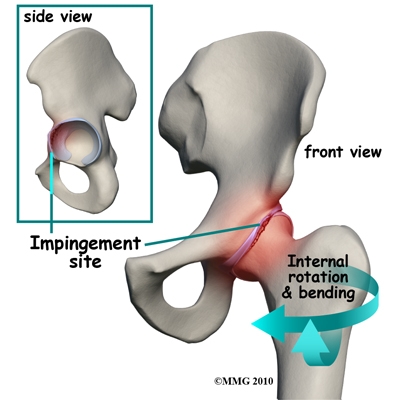Femoro-acetabular impingement (FAI) syndrome is defined as a pain or discomfort experienced in the hip during movement, due to an impingement or abnormal contact in the hip joint. The hip joint is also known as the femoro-acetabular joint, which is formed between the femur (leg) and the acetabulum (pelvis). The femoro-acetabular joint is considered to be a ball and socket joint, which allows the joint to have an increased range of motion. This condition is becoming increasingly common in individuals that present into clinic, in particular those with an athletic background or interest.
In FAI syndrome, the pain is due to altered hip mechanics, which is felt during hip movement. This abnormality causes an impingement between the femur and the acetabulum, which is experienced as pain. The abnormal contact is due to a change in the structure of the femoral head or the acetabulum. An alteration in the femoral head is called a CAM deformity, where there is increased bone growth on the head of the femur. An alteration in the acetabulum is called a Pincer deformity, where there is increased growth of the acetabular rim.

In order to diagnose FAI syndrome, a criteria is used by health professionals:
- Symptoms experienced by the patient
- Examination findings
- Diagnostic Imaging
The main symptom of FAI is hip pain associated with movement, with the addition of clicking, locking or stiffness in the hip joint. Movements that are painful in FAI are internal rotation of the hips and performing a deep squat.
The most common examination finding is pain with the hip impingement test, which is where the knee is bought up towards the chest then towards your belly button.
Diagnostic Imaging can also be used to help confirm a diagnosis of FAI, with X-rays generally used to see the bony abnormalities in the hip joint. However, CT or MRI scans provide higher diagnostic quality, as non-bony structures are able to seen.
In addition to FAI, labral tears are also a common diagnosis for a patient presenting with hip pain. They present in a similar manner, with pain in the groin, over the hip or in the buttock region. Labral tears should be differentiated from FAI by cause, which is usually from falls, sporting injuries or repetitive twisting motions in the hip. Depending on the severity of the tear, conservative treatment may not be the correct method of care, and referral to an orthopaedic surgeon may be required. Post-operative rehabilitation usually consists of strengthening exercises and gentle hip mobility.
Treatment for FAI syndrome typically includes mobilisation of the hip joint, strengthening of the gluteal and lengthening the hip flexor muscles. These muscles will help with stabilising the hip, as well as encouraging correct movement. Core stability exercises can also be used to help with pelvic mechanics, and overall hip and lower back movement.
By: Dr Riya Chowdhry (Chiropractor)


